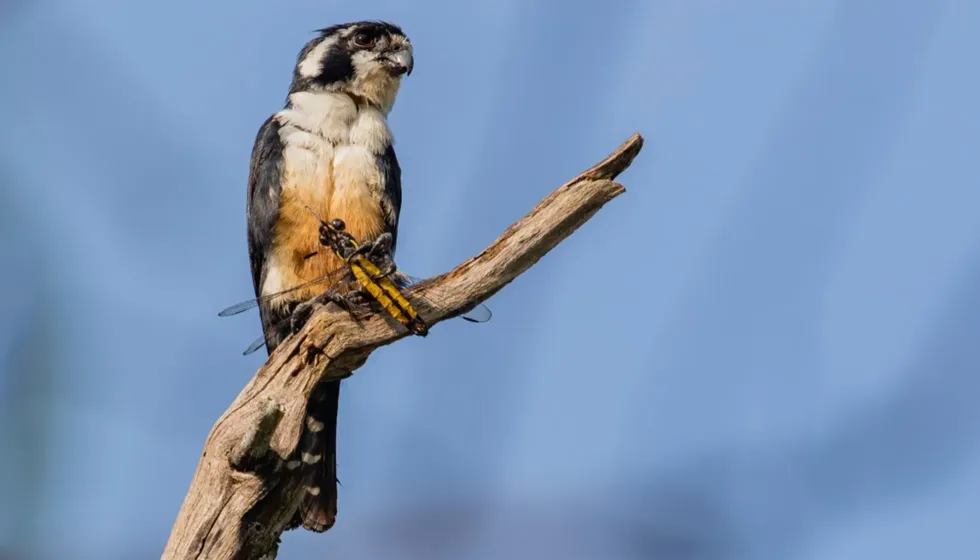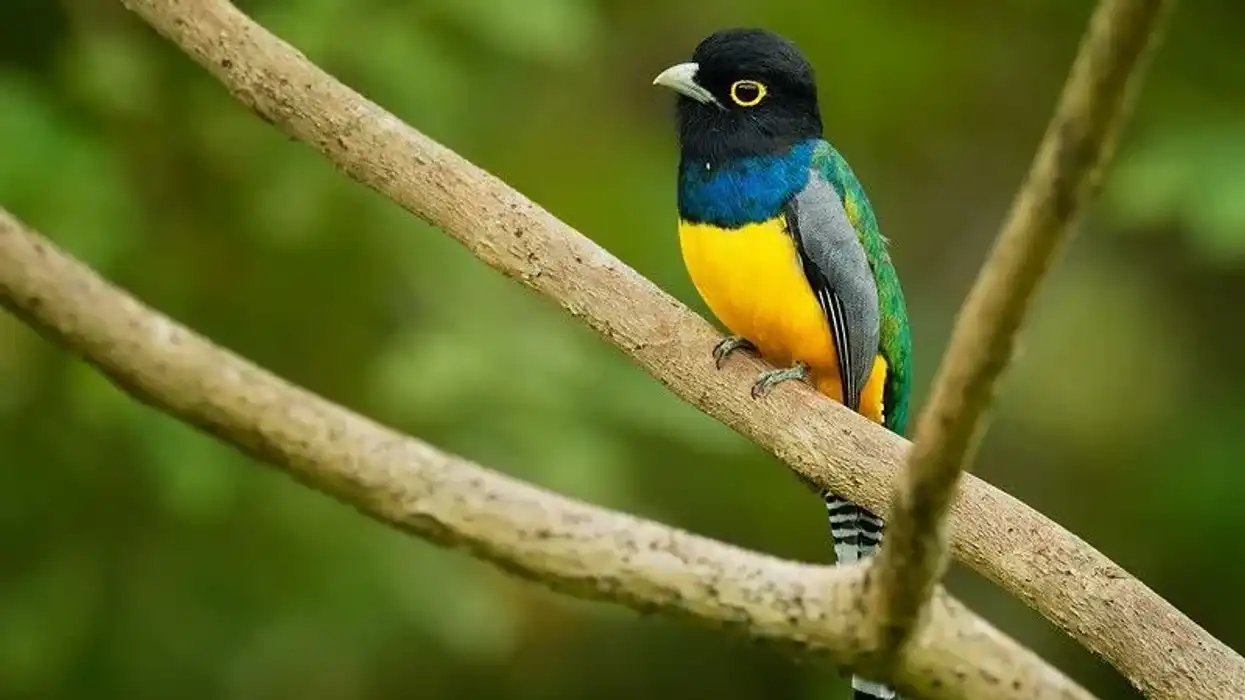The black-thighed falconet (Microhierax fringillarius) belongs to the Aves class of birds and the family Falconidae. The geographic range of these birds is limited to the forest, forest edge, and urban and semi-urban regions of Thailand, Malaysia, Singapore, Myanmar, and Brunei Darussalam.
They are also known to thrive in clearings that are destroyed by forest fires. This species is characterized by a shiny black head, a white chest, and a reddish-brown abdomen. The plumage of their wings and thighs is black, thus justifying their name.
These small birds are known for their spectacular hunting skills, like swiftly catching their prey mid-air. They mostly feed on insects but sometimes they also prey on small birds and reptiles.
The breeding season of black-thighed falconet birds is approximately from February to May. These birds do not build their own nest, instead, they occupy the deserted tree holes of barbets and woodpeckers.
The population of these birds is quite stable but they are facing turmoil in some parts of the world because of deforestation. To know more interesting facts about these birds, keep reading this article. If you liked this article, you may also read about the eyebrowed thrush and the saker falcon.
Black-Thighed Falconet Interesting Facts
What type of animal is black-thighed falconet?
The black-thighed falconet (Microhierax fringillarius) is a type of bird that belongs to the family Falconidae. It is one of the smallest birds of prey and is known for its stunning hunting skills.
What class of animal does the black-thighed falconet belong to?
The black-thighed falconet (from the order Falconiformes, family Falconidae, and genus Microhierax) is a small bird of prey that belongs to the class Aves. The scientific name of this bird is Microhierax fringillarius.
How many black-thighed falconets are there in the world?
There is no exact data on the population of these tiny birds. However, it is estimated that their population range is in the tens of thousands. Therefore the black-thighed falconet (Microhierax fringillarius) species is quite stable. Their geographic range spreads across Southeast Asian countries like Myanmar, Thailand, Singapore, Malaysia, and Brunei Darussalam.
Where does black-thighed falconet live?
The geographic range of these species, belonging to the genus Microhierax, is particularly limited to a forest or forest edge or urban and semi-urban regions of Thailand, Malaysia, Singapore, Myanmar, and Brunei Darussalam.
What is a black-thighed falconet's habitat?
The black-thighed falconet (Microhierax fringillarius) is commonly found in forest edges, in villages, and near other cultivations. These birds are also known to adapt quickly in clearings that are left by forest fires. Apart from this, they are also scattered around rivers and paddy fields.
Who do black-thighed falconets live with?
The black-thighed falconet (Microhierax fringillarius) is known to be social. They hunt for their food together in a pair or with 10 other black-thighed falconets. They also preen each other during the breeding season.
How long does black-thighed falconet live?
There is no conclusive data regarding the lifespan of the black-thighed falconet (Microhierax fringillarius). However, birds from the Falconidae family are known to live approximately for 15 years in the wild, so it can be assumed that this species also has a long lifespan.
How do they reproduce?
The breeding season of the black-thighed falconet (Microhierax fringillarius) is approximately from February to May. During this time, adults mutually preen and engage in mating rituals.
These birds do not build their own nest. After mating, the female bird lays between two and five eggs in the deserted tree holes of a woodpecker or barbet, mostly 20-66 ft (6-20 m) above the ground.
What is their conservation status?
According to the International Union for Conservation of Nature's Red List, the conservation status of the black-thighed falconet (Microhierax fringillarius) is Least Concern. However, this species faces turmoil as a result of deforestation for cultivation and farming purposes.
On the other hand, they are quite adaptable and can adjust to a new habitat quite efficiently. This is why these birds do not face a major threat as of now.
Black-Thighed Falconet Fun Facts
What do black-thighed falconets look like?
The black-thighed falconet (Microhierax fringillarius) is a tiny raptor bird with pointed wings. The plumage of their outer thighs, ear coverts, and wings are black. This bird has shiny black upperparts, a white chest, and a reddish-brown underbelly.
Their tail is black with scattered white spots. It has a tiny and curved bill that helps the bird to hunt efficiently.
Male and female black-thighed falconet (Microhierax fringillarius) birds are almost identical in appearance. However, females are slightly bigger due to their long tails. Nestlings look similar to adults but a part of their forehead is pale chestnut.

We've been unable to source an image of a black-thighed falconet and have used an image of its habitat. If you can provide us with a royalty-free image of a black-thighed falconet, we would be happy to credit you. Please contact us at hello@kidadl.com.
How cute are they?
The fluffy plumage of the black-thighed falconet (Microhierax fringillarius) makes it look adorable. Another adorable feature is how they hang out in a group on a perch!
How do they communicate?
The black-thighed falconet (Microhierax fringillarius) communicates primarily by simple and repeated vocalizations that sound like 'kli-kli-kli'.
How big is black-thighed falconet?
This tiny raptor is 5.5-6.3 in (14-16 cm) in size and its wingspan is 11-13 in (27-32 cm) long. It is almost three times the size of a bee hummingbird, the smallest bird in the world. An adult female black-thighed falconet (Microhierax fringillarius) has a longer tail compared to a male and therefore looks bigger.
How fast can black-thighed falconet fly?
Owing to their swift flight, the exact speed of the black-thighed falconet (Microhierax fringillarius) is not evaluated accurately. Therefore it cannot be determined exactly how fast these tiny birds of prey can fly in quest of food.
It is worth noting, though, that these birds are known for their hunting skills as they can catch their prey mid-air by rapidly chasing them.
How much does black-thighed falconet weigh?
An adult black thighed falconet (Microhierax fringillarius) weighs around 1-1.9 oz (28-55 g).
What are the male and female names of the species?
There are no specific names for males and females of this species. Usually, male and female birds of this species are known as male black-thighed falconet and female black-thighed falconet, respectively.
What would you call a baby black-thighed falconet?
A baby black-thighed falconet (Microhierax fringillarius) is called a chick or a nestling, just like any other bird.
What do they eat?
The black-thighed falconet (Microhierax fringillarius) is a bird of prey that feeds on insects, small birds, and small reptiles. Their diet consists of butterflies, moths, dragonflies, lizards, and sometimes birds like warblers too.
These species are famous for their excellent hunting skills and eyesight which helps them to efficiently catch their prey from mid-air. They also actively hunt insects from flowers and sometimes at night, they catch moths near lamp-posts and other artificial lights.
Are they dangerous?
No, the black-thighed falconet (Microhierax fringillarius) does not pose any danger to humans. However, these species belong to the raptor class of birds and are dangerous to insects and small birds nearby.
Would they make a good pet?
No, these birds are wild birds of prey and should not be domesticated. As you cannot keep these birds as pets, they do not have an average cost.
Did you know...
In Malaysia, these birds are known as 'Rajawali-Belalang Melayu'.
Keeping black-thighed falconets
These are raptor birds who prefer to live in the wild where they can hunt insects, tiny birds, and reptiles. Their geographic range is limited to the forests, villages, and urban areas of south-east Asian countries. They are wild birds and should not be kept as a pet.
Naming the black-thighed falconet
This bird is known as black-thighed falconet because it is characterized by black plumage on its crown as well as its thighs, ear covets, and wings.
Here at Kidadl, we have carefully created lots of interesting family-friendly animal facts for everyone to discover! For more relatable content, check out these sea eagle facts and shikra facts for kids.
You can even occupy yourself at home by coloring in one of our free printable black-thighed falconet coloring pages.










